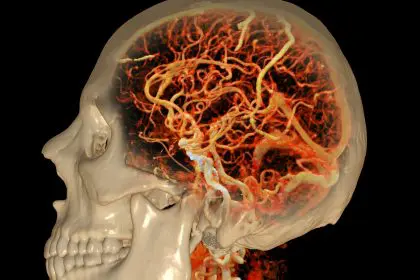The human voice represents one of our most complex biological achievements—a sophisticated interplay between brain, nerves, muscles, and breath that produces the nuanced sounds of human speech. As neuroscience advances, researchers have discovered that the voice functions as a remarkable window into brain health, with subtle vocal changes often preceding more obvious symptoms of neurological conditions by months or even years. This emerging field of vocal biomarkers is transforming how neurologists detect, monitor, and potentially treat various brain disorders by analyzing the aspects of speech that reflect underlying neural processes.
The neural orchestra behind human speech
Human speech production involves an intricate coordination between multiple brain regions, neural pathways, and physical structures. Primary language centers—including Broca’s area, Wernicke’s area, and the arcuate fasciculus—work in concert with motor control regions, emotional processing circuits, and respiratory control systems to produce fluent, meaningful speech.
This complex neural network creates unique vulnerabilities where subtle brain changes can manifest in detectable vocal alterations long before they impact daily functioning. Changes in neural timing, emotional regulation circuits, motor control pathways, or cognitive processing can all leave distinctive vocal fingerprints that trained specialists—and increasingly, artificial intelligence systems—can identify.
The voice contains over 220 different measurable acoustic properties, from frequency and amplitude to more complex features like jitter, shimmer, harmonic-to-noise ratio, and formant structure. Many of these properties correlate strongly with specific aspects of brain function, creating opportunities to detect nascent neurological changes through careful voice analysis.
6 key vocal patterns that signal neurological changes
- Prosodic flattening and emotional blunting
The prosody of speech—its rhythm, stress, and intonation—provides crucial emotional coloring and meaning to verbal communication. This musical quality of language depends heavily on right hemisphere brain regions and the limbic system, which govern emotional processing and expression.
Subtle flattening of prosodic features often represents one of the earliest detectable signs of certain neurodegenerative conditions. This change manifests as reduced pitch variability, diminished emotional expressiveness, and a more monotone quality to speech, sometimes years before cognitive symptoms become apparent.
In particular, a reduction in pitch range and fewer pitch inflections when expressing emotional content can signal early changes in the brain’s frontal-subcortical circuits and right hemisphere emotional processing networks. Research indicates this prosodic flattening may precede clinical diagnosis of certain neurodegenerative conditions by 5-7 years on average.
Voice analysis technology can now detect a 15-20% reduction in prosodic variability compared to age-matched norms—a change typically imperceptible to casual listeners but potentially significant for early intervention. This flattening often occurs independently of content, meaning individuals can still describe emotions verbally while their vocal tone fails to convey the appropriate emotional quality.
- Micro-tremors and subharmonic disturbances
The voice’s stability depends on precise coordination between the brain’s motor planning regions and the peripheral nervous system. Disruptions to this coordination, even minor ones, can create subtle vocal tremors and irregularities.
Advanced voice analysis can detect micro-tremors—rhythmic oscillations in vocal production occurring at 8-12 Hz—that often indicate early changes in certain brain circuits before they manifest as visible physical tremors. These micro-tremors represent fluctuations in the neural signals controlling the laryngeal muscles, creating measurable instability in vocal production.
Similarly, subharmonic disturbances—additional frequency components that appear below the fundamental frequency of the voice—can signal emerging issues with neural timing and coordination. These disturbances create a subtle “roughness” or “gravel” quality that specialized analysis can quantify long before it becomes audibly obvious.
Research indicates these micro-irregularities often precede clinical diagnosis of certain movement disorders by 3-5 years, potentially opening a significant window for earlier intervention. Longitudinal studies show progressive increases in these vocal markers correlate strongly with advancing neurological changes, making them valuable for both detection and monitoring disease progression.
- Articulatory precision degradation
Clear articulation requires exquisite coordination between multiple brain regions and the muscles controlling the lips, tongue, jaw, and soft palate. This precision depends heavily on intact connections between motor planning regions, the cerebellum, and motor execution pathways.
Subtle declines in articulatory precision often manifest years before noticeable slurring or speech difficulties develop. These changes include less distinct consonant production, reduced contrast between vowel sounds, and simplified articulation of complex consonant clusters.
Acoustic analysis can detect a 10-15% reduction in articulatory precision compared to an individual’s baseline—a change typically imperceptible in casual conversation but potentially significant for tracking brain health. This degradation often affects certain sounds first, particularly those requiring the most precise motor control, such as “s,” “t,” “r,” and consonant blends.
Interestingly, this pattern can manifest differently depending on which neural systems are affected. Anterior brain changes typically affect consonant precision first, while changes affecting subcortical structures or the cerebellum may initially impact the timing relationships between syllables while preserving articulation itself.
- Pausing patterns and speech rhythm disturbances
The timing of speech—including the length and placement of pauses—reflects complex cognitive processes including working memory, attention, and language planning. These processes depend on frontal-subcortical networks and connections between language centers and executive function regions.
Changes in pausing patterns often provide early signals of cognitive changes, sometimes years before they impact daily functioning. These changes include increased frequency of hesitations, longer pauses before content words (nouns, verbs), and disruptions to the natural rhythm of speech.
Particularly telling is the increased variability in pause durations, which can signal difficulty maintaining consistent cognitive processing speeds. Advanced analysis can identify a 20-30% increase in pause variability compared to age-matched norms or personal baselines—a subtle change that correlates strongly with early cognitive alterations.
Research indicates distinctive pausing pattern changes may predict different types of cognitive issues. For instance, long pauses followed by function words (like “the” or “and”) often signal different underlying neural changes than extended pauses before content words (like specific nouns or verbs).
- Semantic-syntactic relationship changes
The relationship between the meaning of words (semantics) and the grammatical structure of sentences (syntax) involves extensive neural networks connecting language processing regions with broader cognitive systems. These connections can become vulnerable early in certain neurodegenerative processes.
Subtle changes in the complexity of sentence structure, word choice diversity, and the relationship between ideas often appear years before obvious language difficulties develop. These changes include reduced syntactic complexity, increased use of high-frequency words, and difficulty maintaining cohesive relationships between sentences and ideas.
Analysis of verbal samples can detect a 15-25% reduction in linguistic complexity markers compared to an individual’s educational and occupational baseline—changes that may be missed in routine conversations but potentially signal important neural changes. Particularly telling is the ratio between open-class words (nouns, verbs, adjectives) and closed-class words (articles, prepositions), which tends to shift as certain brain changes progress.
Longitudinal analysis shows these linguistic changes often follow distinctive patterns depending on the underlying condition, with some affecting grammatical structure first while others primarily impact semantic relationships or idea generation.
- Voice-brain coherence disruptions
Beyond the components of speech itself, researchers now recognize the importance of how speech synchronizes with other neurological processes—a feature called voice-brain coherence. This synchronization involves complex relationships between speech centers, arousal systems, and regulatory mechanisms throughout the brain.
Disruptions to this coherence can manifest as mismatches between speech content and vocal delivery, including inappropriate laughter, sudden shifts in vocal quality, or vocal expressions incongruent with the situational context. These disruptions often reflect changes in the brain’s self-monitoring circuits and connections between speech production and emotional regulation systems.
Recent research using simultaneous voice recording and brain imaging has identified specific neural networks involved in maintaining this coherence, allowing for more precise interpretation of these vocal changes. Particularly significant are disruptions to the default mode network and its connections with language processing regions, which can create distinctive patterns of voice-content mismatch.
While these coherence disruptions were once considered too complex to quantify objectively, new analytical approaches combining linguistic content analysis with acoustic feature extraction can now detect these subtle misalignments with increasing accuracy.
Advanced detection technologies transforming diagnosis
The field of vocal biomarkers for brain health has advanced rapidly with the development of sophisticated computational techniques for analyzing speech patterns. These technologies are transforming how clinicians detect and monitor neurological conditions.
Artificial intelligence systems trained on thousands of voice samples can now identify subtle combinations of vocal changes that might escape human detection. These systems analyze dozens of acoustic features simultaneously, recognizing patterns that correlate with specific neurological conditions with increasing accuracy.
Smartphone-based applications are bringing this technology into everyday settings, allowing for longitudinal tracking of vocal patterns during natural conversations. These apps can establish personalized baselines and detect deviations that might warrant further investigation, potentially years before conventional screening would identify issues.
Natural language processing algorithms complement acoustic analysis by examining the content and structure of speech, identifying subtle changes in word choice, grammatical complexity, and idea relationships. The combination of acoustic and linguistic analysis provides a more comprehensive picture of brain function than either approach alone.
Voice stress analysis technologies, originally developed for other applications, have found new utility in detecting subtle changes in vocal tension patterns that may reflect alterations in the brain’s arousal and emotional regulation systems. These technologies can identify changes in subglottal pressure and laryngeal tension that correlate with specific neural pathways.
Clinical applications across neurological conditions
The utility of vocal analysis extends across numerous neurological conditions, with distinctive patterns emerging for different disorders based on which neural systems they primarily affect.
In neurodegenerative conditions like Parkinson’s disease, voice changes often precede the classic motor symptoms by 5-7 years on average. These early vocal markers include reduced loudness, breathiness, increased vocal tremor, and distinctive changes in articulation precision—particularly for consonants requiring fine motor control.
For conditions primarily affecting cognition, changes in pausing patterns, word-finding efficiency, and the complexity of grammatical structures often provide the earliest detectable signals. These changes typically reflect alterations in frontal-subcortical connections and working memory systems before they impact daily functioning.
Cerebrovascular changes, including the cumulative effects of small vessel disease, often manifest in subtle timing disruptions between syllables and words, alongside changes in prosodic variability. These markers can help identify individuals at increased risk for cognitive vascular events before conventional imaging would detect significant abnormalities.
Mood disorders with neurological components frequently show distinctive patterns in emotional prosody, speech rhythm, and articulation energy. Voice analysis can detect these patterns with increasing accuracy, potentially helping differentiate between mood changes of primary psychiatric origin versus those stemming from subtle neurological alterations.
Traumatic brain injuries, even mild ones that show limited findings on conventional imaging, often produce detectable changes in voice quality, timing, and coordination. These vocal markers can help track recovery trajectories and identify individuals who might benefit from more intensive cognitive rehabilitation.
Practical implications for early intervention
The ability to detect neurological changes years before conventional diagnosis carries profound implications for intervention approaches and disease management.
Early pharmacological interventions can potentially begin during the prodromal period—when brain changes are present but symptoms remain minimal—potentially altering disease trajectories before significant neural damage occurs. Voice analysis provides a non-invasive, cost-effective way to identify candidates for such early intervention trials.
Cognitive training and rehabilitation can be tailored based on specific vocal marker patterns, targeting the particular neural systems showing early signs of vulnerability. This personalized approach allows for more focused interventions aimed at strengthening the specific networks showing initial changes.
Lifestyle modifications, including specific forms of exercise, dietary changes, and stress management techniques, show greater efficacy when implemented earlier in disease processes. Voice monitoring can help identify the optimal timing for such interventions and track their effectiveness through changes in vocal biomarkers.
Brain stimulation therapies, including transcranial magnetic stimulation and direct current stimulation, potentially offer greater benefits when initiated during early disease stages identified through vocal analysis. These approaches can target specific neural networks showing initial dysfunction before widespread compensation and reorganization occur.
Ethical considerations and implementation challenges
As voice analysis for brain health advances, important ethical and practical considerations must be addressed to ensure responsible implementation.
Privacy concerns are paramount, as voice data contains potentially sensitive health information. Robust encryption, clear consent procedures, and transparent data usage policies are essential as these technologies move into widespread clinical use and consumer applications.
False positives and psychological impacts require careful consideration, as preliminary findings may create unnecessary anxiety. Systems must balance sensitivity with specificity, and results should be presented with appropriate clinical context and support resources.
Access disparities present another challenge, as advanced voice analysis technologies might initially benefit primarily affluent populations or those with access to specialized care. Efforts to democratize these tools through smartphone-based applications and telehealth integration can help address these disparities.
Cultural and linguistic variations affect many vocal biomarkers, necessitating diverse training data and culturally adapted algorithms. What constitutes “normal” vocal patterns varies significantly across languages, dialects, and cultural contexts, requiring more inclusive development approaches.
Integration with existing healthcare systems presents practical challenges, including training clinicians to interpret voice analysis results, establishing reimbursement pathways, and determining appropriate clinical workflows for these new diagnostic tools.
The future landscape of voice-based neurological assessment
The field of vocal biomarkers for brain health continues to evolve rapidly, with several promising developments on the horizon.
Multimodal approaches combining voice analysis with other non-invasive measures—such as eye movement tracking, subtle gait changes, and digital cognitive assessments—will likely provide even greater diagnostic precision. These complementary data streams can confirm and refine the patterns identified through voice analysis alone.
Predictive modeling using longitudinal voice data may eventually allow for individualized risk assessment and progression trajectories. By tracking changes over time against large databases of disease progression patterns, these models could estimate when someone might transition from subtle vocal changes to clinically significant symptoms.
Treatment response monitoring represents another promising application, using voice analysis to detect subtle improvements or deteriorations following interventions—potentially weeks or months before they would be apparent on clinical scales or subjective reports.
Digital biobanking of voice samples, with appropriate privacy protections, could accelerate research by creating large repositories for analysis. These biobanks would allow researchers to identify new vocal markers, refine existing algorithms, and discover subtle patterns that emerge only with very large sample sizes.
Consumer applications will likely proliferate as the technology matures, potentially including voice assistants that monitor for cognitive changes, smartphone apps for brain health tracking, and integrated systems that provide personalized brain health recommendations based on vocal patterns.
Conclusion: The voice as a neural fingerprint
The human voice, in all its complexity, offers unprecedented insights into brain health that were previously accessible only through expensive imaging techniques or invasive procedures. As our understanding of the relationships between vocal patterns and neural function deepens, voice analysis is emerging as a powerful tool for early detection, monitoring, and intervention across numerous neurological conditions.
While no single vocal marker definitively indicates a specific condition, the patterns of change across multiple speech dimensions can provide remarkably specific information about which neural systems are showing early signs of vulnerability. This specificity allows for more targeted interventions aimed at preserving function and potentially altering disease trajectories.
The non-invasive, cost-effective nature of voice analysis makes it particularly valuable for widespread screening and longitudinal monitoring—uses that could help shift neurological care from its current reactive approach toward a more preventive paradigm. By identifying subtle neural changes years before they impact daily functioning, voice analysis opens new possibilities for maintaining brain health throughout the lifespan.
As this technology continues to evolve and mature, the subtle nuances of how we speak may become one of our most valuable tools for protecting the remarkable organ that enables speech itself—revealing the health of the brain through the very voice it creates.


















